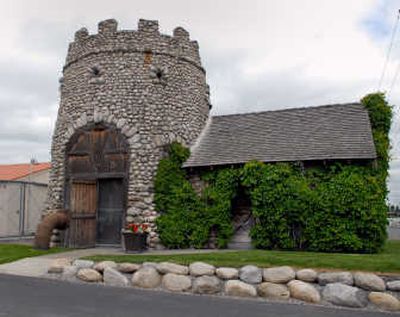Vera Water pumphouse well still works

The little stone house with its attached castlelike tower looks like it comes from another era, which it does.
But there, along busy Evergreen Road in Spokane Valley, the Vera Water and Power Pumphouse No. 1 seems especially out of place. Surely it belongs in a tale of knights and dragons.
This structure that marks the beginnings of the Vera Electric Water Co. is more than just an artifact. It still houses a working well, one of eight which supply water to the 25,000 people in the district today, according to Gail Gibson, district secretary. It is so iconic that a drawing of the 100-year-old native stone building is now part of the letterhead and other logos used by the company.
It houses the company’s first well – and a hand-dug well, at that – that supplied irrigation and domestic water to the Vera section of Spokane Valley, which was being settled in the early 1900s. The tower shelters the well, which can produce 3,500 gallons a minute, and the side-gabled wing, which served as the home of early system superintendents, now is filled with a variety of control equipment.
It was constructed in 1908 with the assistance of Modern Electric Water Co. Donald K. McDonald was one of the founding partners of both companies. He and his partners bought 2,500 acres in the area and broke them up into 10-acre lots, where miniorchards and truck farms sprang up. Vera Electric Water Co. was established at first to provide water for irrigation and then for domestic use; then electricity was also provided.
As a side note, McDonald’s daughter was named Vera, and the company and surrounding community, Veradale, were named for her.
The first superintendent/general manager was Bill Tschirley who, together with Otto Kuchenbuch, pretty much did all the work on the system in the early days. Kuchenbuch, who dug ditches and laid pipe, moved into a home across the street with his bride in 1918. Today his daughter, Helen Haden, and her husband, Don, live in that same house; her sister Lillian Owen also lives in Spokane Valley.
The medieval-looking cobblestone pumphouse structure at 601 N. Evergreen Road was accepted to the National Landmarks of the American Waterworks Association in 1977, and because of its integrity and significant role in the agricultural development of Veradale it is eligible for listing on the National Register or Historic Places, according to a 1998 historic property inventory report issued by Archaeological and Historical Services at Eastern Washington University.